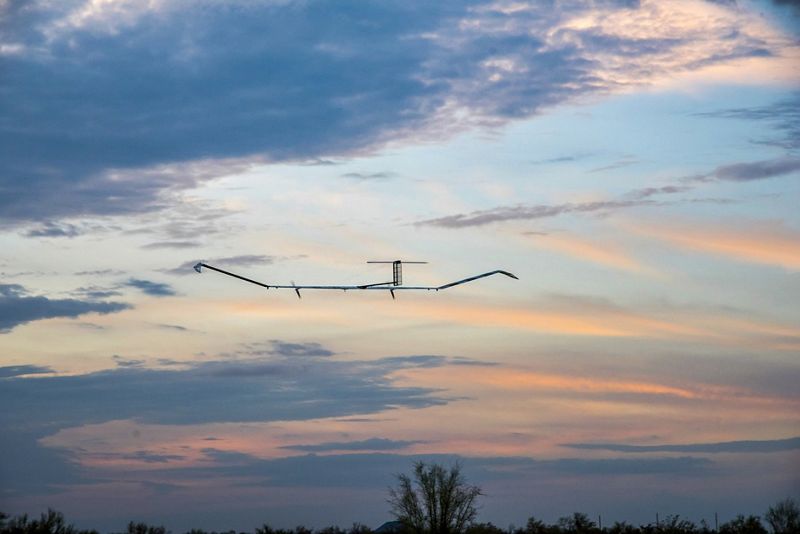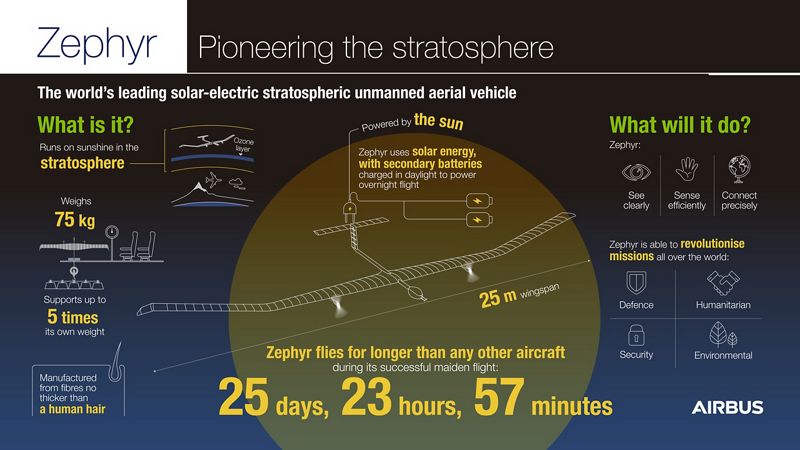Airbus electric airplane flies continuously for 26 days, setting world record
; Date: August 11, 2018
Tags: Airbus »»»» Electric Airplanes
Airbus has flown an unmanned high-altitude airplane for 3 minutes shy of 26 days, beating an endurance record also owned by Airbus. The airplane combines solar panels and energy storage to enable continuous flight, and operates at a 70,000 foot altitude where there is little air turbulence. The primary goal for such an airplane is to implement a kind of very-low-orbit satellite -- that is, remaining at a very high altitude means such an airplane can perform reconnaisance or communications services like a satellite, but without the expense of launching a satellite into orbit.
The 70,000 foot altitude is above the weather, above regular air traffic, and for example is high enough to provide a very wide viewing angle for camera systems, or for telecommunication systems, that might be mounted on such a vehicle. By operating on solar power such an airplane could theoretically operate indefinitely. But of course it is useful for it to land every so often for maintenance.
A couple years ago the Solar Impulse solar electric airplane used a similar drive train to complete an around-the-world journey. In that case the airplane was manned, and therefore its time aloft was limited to pilot endurance. The longest flight of the Solar Impulse was from Japan to Hawaii and (if memory serves) took over five days.

- Touch down after 25 days, 23 hours, and 57 minutes
- System capabilities demonstrated
- Maiden Flight objectives achieved
Farnborough, 8 August 2018 – Airbus Defence and Space announced the successful landing of its first production aircraft of the Zephyr programme, the new Zephyr S HAPS (High Altitude Pseudo-Satellite). After taking off on 11th July in Arizona, USA, Zephyr S logged a maiden flight of over 25 days, the longest duration flight ever made. An application has been made to establish this as a new world record. This maiden flight of the solar powered Zephyr S proves the system capabilities and achieved all the flight’s engineering objectives.
The previous longest flight duration record was also logged by a Zephyr prototype aircraft a few years ago, achieving then more than 14 days continuous flight, which already was ten times longer than any other aircraft in the world.
This new record flight was supported by the UK government and reflects the UK Ministry of Defence’s position as the first customer for this innovative and potentially game changing capability.
Zephyr is the world’s leading, solar–electric, stratospheric Unmanned Aerial Vehicle (UAV). It harnesses the sun’s rays, running exclusively on solar power, above the weather and conventional air traffic; filling a capability gap complimentary to satellites, UAVs and manned aircraft to provide persistent local satellite-like services.
“This very successful maiden flight represents a new significant milestone in the Zephyr programme, adding a new stratospheric flight endurance record which we hope will be formalised very shortly. We will in the coming days check all engineering data and outputs and start the preparation of additional flights planned for the second half of this year from our new operating site at the Wyndham airfield in Western Australia” said Jana Rosenmann, Head of Unmanned Aerial Systems at Airbus.
Zephyr will bring new see, sense and connect capabilities to both commercial and military customers. Zephyr will provide the potential to revolutionise disaster management, including monitoring the spread of wildfires or oil spills. It provides persistent surveillance, tracing the world’s changing environmental landscape and will be able to provide communications to the most unconnected parts of the world.

About the Airbus Zephyr Programme:
The original target mission of the Zephyr is to provide local persistence at an affordable price with a re-usable solar-powered aircraft, providing a wide scope of applications, ranging for example from maritime surveillance and services, border patrol missions, communications, forest fire detection and monitoring, or navigation. Operating in the stratosphere at an average altitude of 70,000 feet / 21 kilometers, the ultra-lightweight Zephyr has a wingspan of 25 meters and a weigh of less than 75kg, and flies above weather (clouds, jet streams) and above regular air traffic, covering local or regional footprints.
Ideally suited for "local persistence" (ISR/Intelligence, Surveillance & Reconnaissance), the Zephyr has the ability to stay focused on a specific area of interest (which can be hundreds of miles wide) while providing it with satellite-like communications and Earth observation services (with greater imagery granularity) over long periods of time without interruption. Not quite an aircraft and not quite a satellite, but incorporating aspects of both, the Zephyr has the persistence of a satellite with the flexibility of a UAV. The only civil aircraft that used to fly at this altitude was Concorde and only the famous military U2 and SR-71 Blackbird could operate at similar levels. The Zephyr successfully achieved several world records, including the longest flight duration without refuelling (more than two weeks, 14 days, nearly 340 hours, that is ten times longer than any other aircraft in the world), as well as very high altitude flights (70,740ft/ 21 Kilometers).
About Airbus
Airbus is a global leader in aeronautics, space and related services. In 2017 it generated reported revenues of € 67 billion – or € 59 billion restated for IFRS 15 - and employed a workforce of around 129,000. Airbus offers the most comprehensive range of passenger airliners from 100 to more than 600 seats. Airbus is also a European leader providing tanker, combat, transport and mission aircraft, as well as one of the world’s leading space companies. In helicopters, Airbus provides the most efficient civil and military rotorcraft solutions worldwide.
Airbus Zephyr S maiden flight launch - 11 July 2018
Taking off from Arizona, US on 11 July, Airbus Defence's solar powered UAV, the British-built Zephyr S, has smashed the existing endurance record for unrefuelled, unmanned flight by staying aloft for 25 days, 23 hours and 57 minutes.
This, the maiden flight of the production Zephyr S HAPS (high altitude pseudo satellite) for the UK MoD, once verified, almost doubles the existing endurance flight record of 14 days, 22 minutes for UAVs, set by a previous Zephyr prototype in 2010.
The solar-powered Zephyr UAV, which weighs less than 75kg, flies at 70,000ft, above air traffic and weather, to provide a new class of platform for persistent surveillance, observation, communications relay or connectivity for military or commercial customers.
Airbus said that the maiden flight saw test objectives met with further flights are planned in the second half of 2018.

